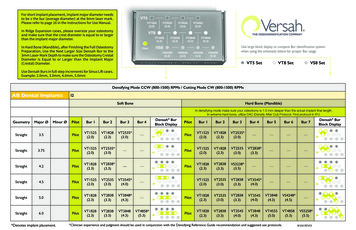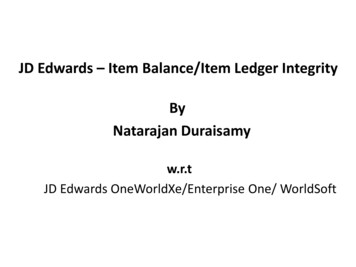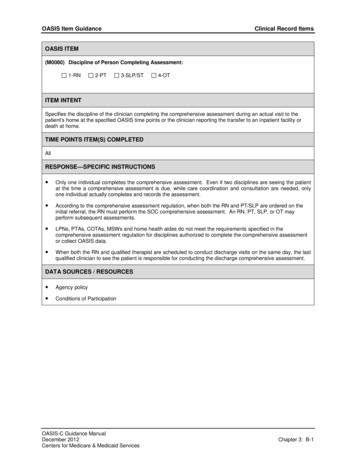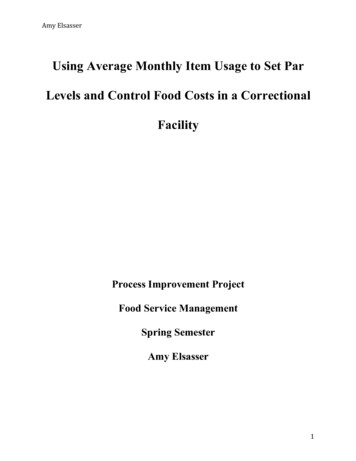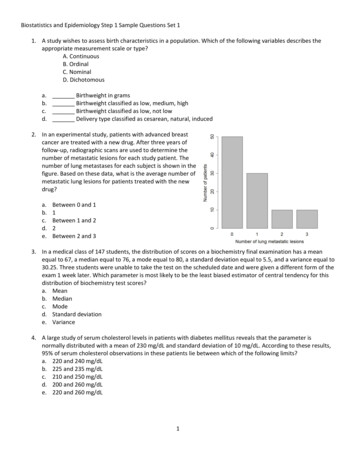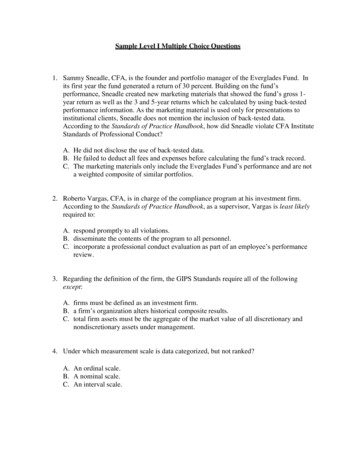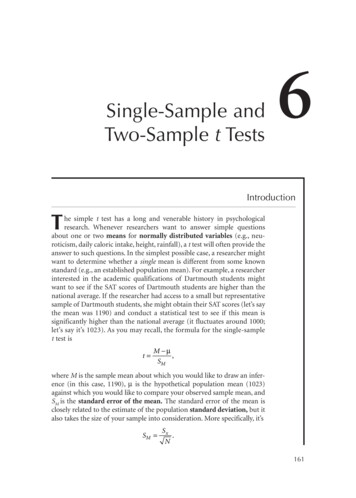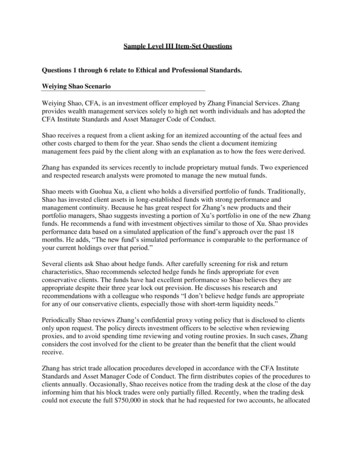
Transcription
Sample Level III Item-Set QuestionsQuestions 1 through 6 relate to Ethical and Professional Standards.Weiying Shao ScenarioWeiying Shao, CFA, is an investment officer employed by Zhang Financial Services. Zhangprovides wealth management services solely to high net worth individuals and has adopted theCFA Institute Standards and Asset Manager Code of Conduct.Shao receives a request from a client asking for an itemized accounting of the actual fees andother costs charged to them for the year. Shao sends the client a document itemizingmanagement fees paid by the client along with an explanation as to how the fees were derived.Zhang has expanded its services recently to include proprietary mutual funds. Two experiencedand respected research analysts were promoted to manage the new mutual funds.Shao meets with Guohua Xu, a client who holds a diversified portfolio of funds. Traditionally,Shao has invested client assets in long-established funds with strong performance andmanagement continuity. Because he has great respect for Zhang’s new products and theirportfolio managers, Shao suggests investing a portion of Xu’s portfolio in one of the new Zhangfunds. He recommends a fund with investment objectives similar to those of Xu. Shao providesperformance data based on a simulated application of the fund’s approach over the past 18months. He adds, “The new fund’s simulated performance is comparable to the performance ofyour current holdings over that period.”Several clients ask Shao about hedge funds. After carefully screening for risk and returncharacteristics, Shao recommends selected hedge funds he finds appropriate for evenconservative clients. The funds have had excellent performance so Shao believes they areappropriate despite their three year lock out prevision. He discusses his research andrecommendations with a colleague who responds “I don’t believe hedge funds are appropriatefor any of our conservative clients, especially those with short-term liquidity needs.”Periodically Shao reviews Zhang’s confidential proxy voting policy that is disclosed to clientsonly upon request. The policy directs investment officers to be selective when reviewingproxies, and to avoid spending time reviewing and voting routine proxies. In such cases, Zhangconsiders the cost involved for the client to be greater than the benefit that the client wouldreceive.Zhang has strict trade allocation procedures developed in accordance with the CFA InstituteStandards and Asset Manager Code of Conduct. The firm distributes copies of the procedures toclients annually. Occasionally, Shao receives notice from the trading desk at the close of the dayinforming him that his block trades were only partially filled. Recently, when the trading deskcould not execute the full 750,000 in stock that he had requested for two accounts, he allocated
100,000 of the stock to the 5 million dollar private account and the remaining 500,000 ofstock to a 25 million dollar institutional account.During the next month, Zhang’s founder is accused by regulatory authorities of a number ofviolations including misappropriation of client funds. The same day, a team of senior portfoliomanagers leave Zhang to start their own firm. Zhang instructs its personnel not to discuss eitherof these developments with current or prospective clients.1. Are the fee disclosures made by Shao to his client consistent with the CFA Institute AssetManager Code of Professional Conduct?A. No.B. Yes, because Shao disclosed how fees are derived.C. Yes, because Shao itemized the management fees paid on the client’s behalf.2. By recommending that Xu switch a portion of his portfolio to a new Zhang fund, doesShao violate any CFA Institute Standards of Professional Conduct?A. No.B. Yes, because he has a conflict of interest as the new funds are proprietary.C. Yes, because the fund data used in the performance comparison was simulated.3. By recommending hedge funds, does Shao violate any CFA Institute Standards?A. No.B. Yes, because hedge funds have risk characteristics that are not suitable forconservative investors.C. Yes, because the hedge funds recommended are not suitable for conservativeinvestors with short-term liquidity requirements.4. Is Zhang’s proxy voting policy consistent with the requirements and recommendations ofCFA Institute Standards and the Asset Manager Code of Conduct?A. Yes.B. No, because the proxy voting policy should be disclosed to all clients.C. No, because voting of all proxies is a part of the management of client investments.5. When allocating the shares on the partially filled block order does Shao violate any CFAInstitute Standards?A. No.B. Yes, because he fails to disclose the firm’s trade allocation policies.C. Yes, because he should allocate shares to client accounts only after the order iscompletely filled.
6. According to the CFA Institute Asset Manager Code of Conduct, Zhang must disclose theinformation regarding its:A. founder only.B. team of senior portfolio managers only.C. both the founder and the team of senior portfolio managers.Questions 7 through 12 relate to Risk Management Applications of Derivatives.Joenia Dantas Case ScenarioJoenia Dantas is a financial risk manager for Alimentos Serra (AS), a Brazilian manufacturer andexporter of soybean-based food products. AS is a privately held corporation, wholly owned byCesar Serra. Recently, AS took out a R25,000,000, four-year, floating-rate bank loan requiringsemi-annual payments of interest based on SELIC (Banco Central do Brasil’s overnight lendingrate) plus a spread of 4.50 percent and repayment of principal at maturity. Serra believes thatinterest rates will rise in the near future and worries that AS will be unable to absorb the higherloan costs associated with an increase in rates. Dantas tells him that she will convert the loan toa 10.80 percent fixed rate by entering into the pay-fixed side of a four-year, R25,000,000notional principal interest rate swap with semi-annual payments that exchanges SELIC for afixed rate of 10.80 percent. She explains that the swap will act as a hedge for the loan, reducingthe company’s net cash flow risk and net market value risk.Discussions with Dantas about using interest rate swaps to reduce risk cause Serra to think aboutthe fixed income portion of his personal investment portfolio, which includes R12.0 million inbonds that have a modified duration of 5.50 years. Serra’s beliefs about rising interest ratesmake him want to reduce the bond portfolio’s modified duration to 2.00 years using interest rateswaps. In order to determine the correct swap position, he needs to learn how to calculate themodified duration of a swap. He asks Dantas how to do this. She explains it to him, using theexample described in Exhibit 1.Exhibit 1Data for Swap ExampleMaturity of swapPayment structureFixed rate on swapDuration of 4-year, 10.8% coupon bond4 yearssemiannual10.8%2.91 yearsSerra decides to use a swap that has a modified duration of -2.40 years for the pay-fixed side toreduce his bond portfolio’s duration to the desired level.Dantas knows that AS currently needs to borrow an additional R30,000,000 for 5 years to fundits growth. Brazilian credit markets have tightened and it would cost 17.70 percent per year toborrow this amount locally, but AS can obtain a yen-denominated loan at a fixed rate of 9.50percent. This would expose it to substantial currency risk. A 5-year currency swap is available
in which AS would pay interest in real to the counterparty at 12.20 percent and receive interest inyen from the counterparty at 7.10 percent. The current exchange rate is 40/R.In addition to the current needs, in six months AS will enter into a four-year, quarterly payment,R50,000,000 loan to fund local projects. Dantas expects to borrow these funds at a floating rateand convert the loan to fixed using an interest rate swap. She explains to Serra that AS cancommit to a fixed rate of 14.3 percent for the future loan by buying a payer swaption today withan exercise rate of 14.3 percent for a four-year swap with quarterly payments and a notionalprincipal amount of R50,000,000.7. Dantas’ explanation of her plan to convert the four-year loan from floating to fixed ismost likely:A. correct.B. incorrect, because the fixed loan rate will be 15.30%.C. incorrect, because the swap should be entered to pay SELIC.8. Dantas’ characterization of the interest rate swap as a hedge for the bank loan is mostlikely:A. correct.B. incorrect, because the swap increases the cash flow risk of AS.C. incorrect, because the swap increases the market value risk of AS.9. The duration of the interest rate swap described in Exhibit 1 is closest to:A. -2.41 years.B. -2.66 years.C. -2.91 years.10. In order to reduce the duration of his bond portfolio to the desired level, Serra will enterinto a pay-fixed swap position with a notional principal closest to:A. R17.5 million.B. R27.5 million.C. R42.0 million.11. If AS enters into the yen-real currency swap with a notional principal of 1.2 billion(R40.0 million), net yen interest expense for each year is closest to:A. 28.80 million.B. 85.20 million.C. 114.00 million.
12. Dantas’ description of the use of a swaption in anticipation of future borrowing is:A. correct.B. incorrect, because AS should enter into a receiver swaption.C. incorrect, because the fixed rate paid on the loan may be less than 14.3%.Questions 13 through 18 relate to GIPS.Redlands Case ScenarioRedlands Asset Management (RAM) is an active equity manager specializing in the AsianPacific region. The firm was founded by Carol Schroeder, CFA at the beginning of 2006, withseveral members of her family serving as the firm’s first clients providing the initial managedassets for the firm.Schroeder has compiled the information in Exhibit 1 and plans to use it to market RAM toinstitutional investors.Exhibit 1Redlands Asset Management GIPS Compliant PerformanceAsia-Pacific Composite. (1/Jan/2006 thru 31/Dec/2008)Year20062007200844.8%66.9%80.7%Return Gross of Fees43.1%60.2%85.6%Benchmark Return51533# of Portfolios6.7%5.1%Composite Dispersion3507601,630Period Ending TotalAssets ( millions)14%25%52%% of Firm AssetsNotes:1. Performance results are presented gross-of fee so that they represent the return on assetsreduced by any trading expenses incurred during the period.2. The Asia-Pacific composite includes two non-fee-paying accounts of the Schroederfamily.3. A complete list and description of composites and their strategies, including any that havebeen discontinued within the last five years, is available upon request.4. Portfolio valuations are computed monthly and are denominated in US dollars.5. RAM uses cash-basis accounting for the recognition of interest income on its holdings ofpreferred stock.6. The pricing source was changed prior to the end of the reporting period because, inmanagement’s opinion, performance was not fairly represented. The new source hassignificantly improved the firm’s results.
7. RAM trades securities in illiquid markets with substantial political and economic risks sotrades are recorded on a settlement date basis to ensure that these trades have beencompleted before they are included in performance calculations.8. The composite presented above has been GIPS verified.13. Which of the following performance presentation notes contains an error or omission thatis most likely to prevent RAM from being in compliance with the GIPS standards?A. Composite list availability.B. Non-fee paying accounts disclosure.C. Disclosure concerning discontinued composites.14. Which of the following performance presentation notes most likely comply with therecommendations and requirements of the GIPS standards?A. Pricing source.B. Cash-basis accounting.C. Returns calculated gross of fees.15. Which of the following performance presentation notes would least likely prevent RAMfrom being in compliance with the GIPS standards?A. Monthly valuations.B. Non-fee paying accounts.C. Settlement-date accounting.16. Which of the following concerning fees in RAM’s performance presentation most likelymeets GIPS standards?A. Gross of fee labeling.B. The firm’s fee schedule.C. The deduction of any other fees.17. Does RAM’s performance presentation most likely meet GIPS standards concerningdispersion?A. Yes.B. No, the method chosen must be disclosed.C. No, the standard deviation must be presented.
18. RAM’s verification most likely does not meet GIPS standards concerning verificationbecause:A. composite verification is not allowed.B. the minimum time period has not been met.C. the calculation methodology must be disclosed.Answers are provided beginning on the next page.
Answers to Sample Level III Item-Set QuestionsWeiying Shao Scenario1. Are the fee disclosures made by Shao to his client consistent with the CFA Institute AssetManager Code of Professional Conduct?A. No.B. Yes, because Shao disclosed how fees are derived.C. Yes, because Shao itemized the management fees paid on the client’s behalf.Answer: AAsset Manager Code of Professional Conduct, CFA Institute2009 Modular Level III, Volume 1, p. 215Study Session 2-6-bInterpret the Asset Manager Code in situations presenting issues of compliance,disclosure, or professional conduct.The Asset Manager Code of Conduct requires that managers disclose to each client theactual fees and other costs charged to them, together with itemizations of such charges,when requested by clients. The disclosure should include the specific management fee,incentive fee, and the amount of commissions the manager has paid on the client’s behalfduring the period plus any other costs such as custodian fees. The Asset Manager Codeof Conduct also requires managers to use plain language in presenting information toclients. Shao did not disclose all fees as commissions were left out and a descriptionusing plain language was also not used.2. By recommending that Xu switch a portion of his portfolio to
1. Are the fee disclosures made by Shao to his client consistent with the CFA Institute Asset Manager Code of Professional Conduct? A. No. B. Yes, because Shao disclosed how fees are derived. C. Yes, because Shao itemized the management fees paid on the client’s behalf. 2. By recommending that Xu switch a portion of his portfolio to a new Zhang fund, does
